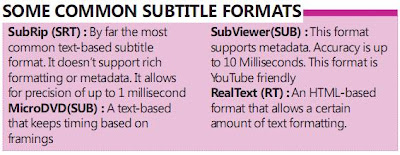Working with Subtitles : Tutorial
Since the advent of the video culture, many have felt the need to manipulate subtitles for their videos.
Synching subtitles
One of the most common reasons why subtitles may be out of synch is a simple delay. This is a relatively easy problem to fix. The second cause of subtitles being out of synch has to do with the frame rate. The frame rate of the movie and that of the subtitles does not match. This causes the subtitles and the movie to go at different speeds. In such a case even if the subtitles and the dialogues start at the same time, towards the end of the video you may get a delay. The third is a combination of these two reasons. This is when the process of scaling comes into the picture.
Solutions
The easiest fix for mismatching subtitles is to search for the exact file name with date and other meta data (such as “1 CD”, [2008], 700MB). Often, this should give you the subtitle file you’re looking for. The operations described below are performed using an easy to use subtitles manipulation software known as Subtitle Workshop4.
Delay in subtitles
When you start playing a video, note the exact time when the first dialogue starts. Next note the instant when the first subtitle appears. The difference between the two timings is the delay. For example, if the subtitles start appearing around two seconds before the actual dialogues then you need to add a delay of 2 seconds. Similarly, you may need an advancement (negative delay) of -2 seconds. To add delay, open the subtitle file by going to File>Load Subtitle or [Ctrl] + [O]. Next go to Edit > Timings > Set delay. From the drop down list, change to either positive (+) or negative (-) delay and enter the delay in milliseconds.
Mismatching framerates
To find out the framerate of a particular video file open it in VLC player and go to Tools > Codec Information or [Ctrl] + [J]. Then open the corresponding subtitle file for that video in Subtitle Workshop4. On the top panel of the interface, switch the Mode to Frames from the drop-down menu. You will have options such as 23.976 fps. Choose the appropriate one. Click File > Save to save the changes on to the same file. Note that the time stamp will not get affected with this change and that the subtitle format must depend on framing to keep time.
 For synchronizing
For synchronizing To synchronies using scaling, you will have to open both the video file as well as subtitle file in Subtitle Workshop. Go to Video > Open to open the video. Go to File > Load Subtitles for adding subtitles. The subtitle entries are displayed in the bottom panel of the screen. To synchronies mismatching subtitles the idea is to fix on two synchronizing points. One point is the time when the first line is spoken and the other is the point at which the last dialogue is spoken. Scroll to the point on the video where the first dialogue is spoken (eg. 4:25). Next select the subtitle that should appear at that point. Now go to Video > Synchronization > Mark as first sync point or hit [Ctrl] + [1]. Go to the point on the video where the last dialogue is spoken and simultaneously select the last subtitle entry. Hit [Ctrl] + [2]. The application will now ask you if you wish to synchronies as per the reference points. Click Yes.
 Combining subtitle files
Combining subtitle files At times we get subtitle files that are meant for two CD video files, while the video file that we have is a single CD 700 MB .Avi. What do you do in such a case? The quick fix solution is to apply a delay (equal to the duration of the first CD) to the second subtitle file. The long term fix is to try and combine the two files. Let’s consider the files to be SRT. Open the CD2 SRT file in Subtitle Workshop. Add a delay of the duration of the first CD. Now select all subtitles [Ctrl] + [A] and hit [Ctrl] + [C] to copy the same. Open the CD1 SRT and scroll down to the last entry. Hit [Ctrl] + [V] to paste, and then save the changes in a new file which will have the combined subtitles
Adding subtitles
Subtitle Workshop also allows you to add subtitles to your own video. In doing so, there are a few terms we need to understand viz. Show, Hide and Duration. Show is the point at which the subtitle will appear. Hide is when it will fade. And the duration is the time-period for which it will remain on the screen. To add subtitles click File > New. Next load your video. The best way is to pause video where you want the subtitle to appear, hit the [Insert] key and begin typing the subtitle script. Increase duration and then move on to the next dialogue and hit [Insert] a new subtitle entry with the corresponding time stamp will be created. You can also change the position of the subtitles by using the vertical scroll bar on the left of the video window. Similarly color, bold, italics formatting options are available. Once you are done click on File > Save As. The application supports almost all known subtitle formats. Choose a file type that supports the formatting you have added (if any).




 TechQuark is a mobile-friendly website. Simply bookmark
TechQuark is a mobile-friendly website. Simply bookmark 